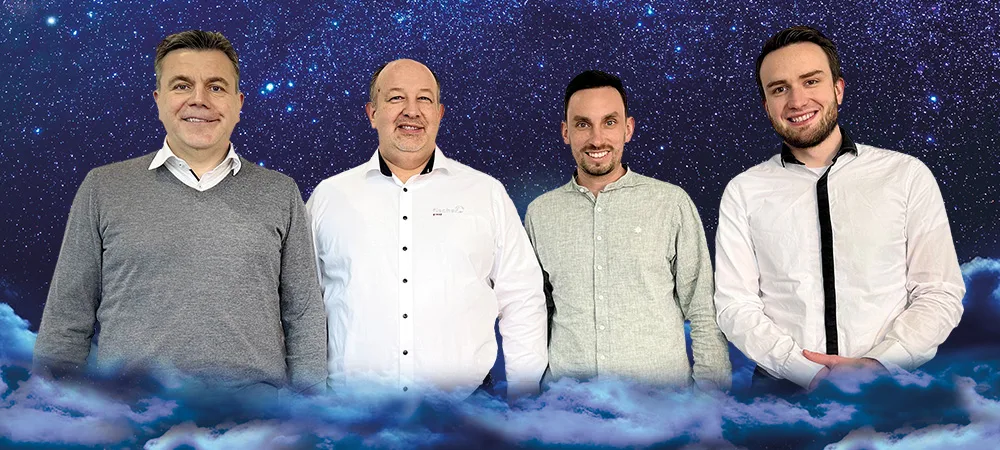Microsoft and SAP: A sky-blue affair


At the beginning of the year, Microsoft and SAP announced the expansion of their cooperation, the technical details of which and the implementation timetable are expected shortly. One of the plans is for Microsoft Teams to become an integral part of SAP's enterprise solutions.
S/4 Hana, SuccessFactors, Sales Cloud and Analytics Cloud have been named so far. These integrations are expected to be available in mid-2021. The linking of collaboration tools with IT-supported business processes promises obvious advantages for everyday work, as can be briefly outlined using the following example.
Just put yourself in the position of a clerk in production preparation. You notice that the last delivery was incomplete and now important materials are missing in production? You would probably now frantically search for the information of the last deliveries and the contact data of the appropriate contact person.
Once they have been found, they pick up the phone. In the real world of business, there is much to suggest that the contact person is unavailable - at least at the first attempt. As a result, you have to try again or leave a message to make an appointment. This effort and time can be saved in the future.
You simply need to open a chatbot in your S/4 Hana that automatically identifies the right contact, contacts them, finds a suitable appointment and sets it up via Microsoft Teams. Afterwards, all you need to do is join the Teams meeting with one click to resolve the delivery issue - without wasting important time on futile calls beforehand.
The latest cooperation venture between the two software heavyweights is not really surprising. It follows on from similar, almost forgotten attempts in the past, such as the Mendocino project with the Duet software. The success remained comparatively manageable. Another example is the Embrace program launched in 2019.
Both companies are working to comprehensively expand the existing strategic partnership to accelerate the adoption of S/4 on Microsoft Azure. The seriousness and chances of success have increased again significantly in 2021, as two women have recently joined the SAP Executive Board, both of whom were previously employed by Microsoft - Sabine Bendiek and Julia White.
The starting position today is more promising, especially since external conditions are pushing for more cooperation. This is because integration is taking place in the cloud, specifically in Microsoft Azure. The advantages of this sky-blue affair are quickly cited: Compared to on-premises approaches, the operation and complexity of an integration are drastically simplified with the shift to the cloud.
The integration plays into SAP's cloud-first policy: As part of the new cooperation, the company's own solution portfolio, primarily S/4, is to be linked more intensively with the infrastructure services of Azure. From a sober point of view, those responsible at this point are counting on participating in Microsoft's cloud success. For its part, the U.S. company is benefiting from social developments in the context of digitization, which are being amplified by the consequences of the Covid 19 pandemic.
Under the heading of "New Work," future working environments will be freed from fixed physical constraints. The right - and in some cases the obligation - to work in a home office, which was introduced in the wake of the Infection Protection Act, is becoming the new normality.
The flexibility and efficiency of virtual collaboration are much higher than those of face-to-face meetings. Hardly anyone will miss the tiresome, now obsolete struggle to find a suitable meeting date and room. The prerequisite for this new way of working and organizing is a powerful digital workplace, as can be implemented by and with Microsoft Teams.
However, another building block is needed for greater efficiency in everyday work. Only the connection of business processes, i.e., enterprise applications, to the collaboration tools promises higher productivity in everyday work, as briefly outlined in the opening example.
If Microsoft and SAP deliver on their promise to link the two environments more closely, they will not only generate real added value for joint customers. They would also develop real, innovative design power with a view to "New Work". In addition to dovetailing at the business process and workflow level, it includes joint functions for easier commissioning and administration.
Initially, simple integration scenarios are planned for appointment finding and scheduling meetings as well as finding the right customer/supplier contact. Later, more in-depth and certainly more complex interlocking will follow. In a few weeks, we will learn more details in order to evaluate the concrete result of the sky-blue affair.









